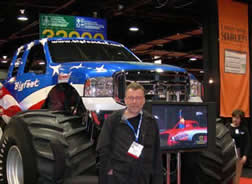- Join our Team
- Resources
-
Account
- |
- Cart
- EN FR
Is the American dream still alive ?

April 01, 06
Francis Cadin, Datakit CEO, met so many people at SolidWorks World 2006 in Las Vegas that he decided to cross the Atlantic again to check out two major trade shows: NDES in Chicago and WESTEC in L.A. Meanwhile, his team was manning booths at the Industrie show in Paris (France), Eurostampi at Parma (Italy) and was taking part in the Step forum at Asheville (USA).


Francis Cadin explains why being at these events is so important: “direct contact with users and potential customers in the field is by a mile the best way to find out what they need and to suggest solutions for 2D, 3D, and FD&T (some people say GD&T) or PMI , and the features and services that they are looking for. By talking it over, they have the opportunity to find out the breadth of our product range, for example for reading data from Catia V5 or which new formats we are offering. Another example: we hear a lot about the JT format but in reality few customers have made enquiries. By phone or e-mail, it isn’t always easy to go into details on these issues, and even harder still to separate real specific needs from more general demands.” He adds: “meeting our US dealers also gives us a chance to gauge whether some of our marketing ideas really have the kind of impact we are looking for. We consider it normal to supply free trial software but it’s much more important to know whether people are liking the product.”
In all, Francis Cadin met 18 customers and prospects during and after the show, strengthening bonds and creating exciting prospects for future collaboration. With so much positive return, Datakit can look forward to building up its business on the North American market.
This is a high-potential arena for Datakit with some of the world’s major players representing all the areas in which Datakit does business, notably CAD, measurement, digital simulation, viewing, and CAM.


In CAM for example, the California-based Gibbs
and Associates has been a Datakit customer for more than 6 years. Interoperability is central to its strategy. While focusing on simple and powerful CAM capabilities as a real alternative to manual programming, the company has successfully addressed the needs of markets across-the-board. Its CAM offering, certified by Autodesk, Solid Edge and SolidWorks, opens the door to businesses that are seeking to work directly on models that have been created either by their own design offices or supplied by customers, while enjoying a homogeneous environment.
It naturally offers a large choice of exchange formats, including - and this is where Datakit comes in - the ability to read Catia V4 and V5. John Callen, Marketing vice president, explains: “our customers receive their original data from various sources. Standard formats remain important, but reading proprietary formats is tending to become an imperative. Over the last few years, this has become a clear trend in major industrial groups like Boeing, Ford, General Dynamics, General Motors, Lockheed Martin and Raytheon, and we are also seeing it in much smaller companies.“
The company, founded in 1982, has always been a pioneer. Bill Gibbs, company founder and president, looks back: “when we launched GibbsCAM in 1984, we were looking for a solution to the problem of programming NC machine tools at a time when most American households still hadn’t even seen a computer screen. Since then we have always had the same determination to develop solutions that are open to our customers’ multiple environments.” Gibbs is adamant: “No way should reading data be an obstacle. High-quality interfaces make it so much easier for our customers to demonstrate their know-how.”